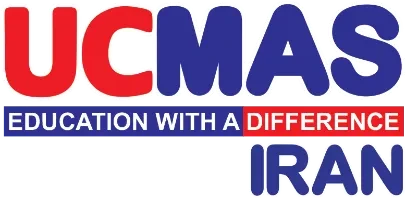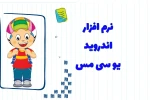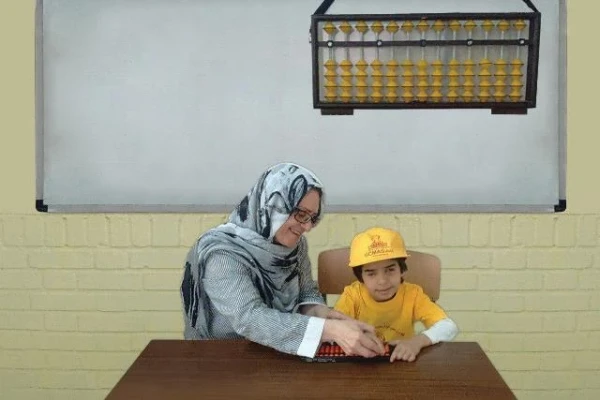What is Abacus? History, Types & Modern uses | UCMAS

The abacus, a calculator dating back to ancient times, is an old yet practical tool that has served as a companion for human calculations for centuries. In today's world, where electronic calculators take the lead, it might seem strange to some that the abacus is still in use. But why is that? What exactly is an abacus, and what secrets does it hold? In this article, we intend to take a journey into the fascinating world of the abacus and become acquainted with this ancient and practical tool. So, stay with us.
What is an Abacus?
The abacus is a mechanical tool used for mathematical calculations. Also known as a counting frame, this tool typically consists of a rectangular frame with multiple vertical rods. Beads are placed on these rods, allowing for the display and manipulation of numbers by moving them up and down.
The number of rods and beads in an abacus can vary depending on its type. In Iran and many other countries, the decimal abacus is used. This abacus usually has 11 rods, with one rod separated from the rest to represent the units place. Each of the other 10 rods contains 10 beads, with nine of them placed below the rod and one bead above it.
The abacus is a tool for performing the four basic arithmetic operations (addition, subtraction, multiplication, and division) in mathematics, and in more advanced settings, it is also used for calculating fractions and square roots.
Today, Asian shopkeepers still use the abacus for their calculations. Japan, one of the largest producers of modern electronic devices, is among the countries where the abacus is commonly used. The first thing that catches the attention of any traveler in Japan is the use of the abacus by Japanese shopkeepers. They quickly calculate the prices of goods with the abacus and their skilled hands, and after a few swift and adept movements, they tell the customer the price.
The Evolution of Ancient Counting Methods
Before diving into the specific details about what is abacus, it helps to understand how humans got here. Thousands of years ago, people used stones, sticks, or even marks in the sand to keep track of their trades and gather basic data. Eventually, the concept of a counting board emerged—an early prototype that set the stage for a fully-fledged abacus.
A Shift from Loose Counters to Organized Frames
Imagine trying to keep track of large quantities of sheep or bushels of grain with random pebbles. It’s easy to lose count, isn’t it? Early societies found that placing stones in rows or columns offered a better visual track of numerical values. Over time, this system advanced into a recognizable abacus, with beads strung on rods or wires.
Who Invented the Abacus?
People often ask, Who invented abacus? or Who created the abacus? The truth is that no single individual can claim sole credit. Different cultures developed their own versions, so the invention seems more like a group project across multiple civilizations. Scholars generally point to the Sumerians, ancient Egyptians, and Babylonians for some of the earliest counting boards. The design that most of us recognize today, however, took shape in various Asian territories—particularly China and Japan—over centuries.
A Collaborative Invention
- Chinese Suanpan: Many historians suggest that the Chinese suanpan might be among the oldest devices recognizable as an abacus.
- Egyptian and Babylonian Counting Boards: These civilizations had flat boards with lines drawn across them, and counters were moved to mark values.
- Greek and Roman Variations: They used flat surfaces with carved lines and pebbles or metal counters for basic arithmetic.
In many ways, the abacus was a communal achievement. Every region contributed a tweak here and a unique feature there, culminating in the flexible tool we see around us today.
Types of Abacus
Wondering What is the main use of an abacus? One big clue lies in the wide range of variations you’ll find around the globe. Each type has its own flair, plus practical differences in shape and bead configuration.
1. The Suanpan (Chinese Abacus)
The suanpan is typically rectangular and has two beads on the upper deck and five beads on the lower deck, for each rod. It’s known for its versatility, making it capable of complex calculations including basic arithmetic, square roots, and even certain advanced operations.
2. The Soroban (Japanese Abacus)
The soroban evolved from the Chinese design but usually has one bead on the top and four on the bottom per rod. This streamlined arrangement is intended for speed and simplicity, often focusing on core arithmetic functions like addition, subtraction, multiplication, and division.
3. The Schoty (Russian Abacus)
The Russian schoty is slightly different in appearance, with a single deck of beads separated by a crossbar. The beads are often grouped in fives, which helps track currency calculations. You might see cashiers using a schoty in some traditional shops, especially for quick daily arithmetic.
4. The Modern Recount
Some educational companies offer newly designed frames that keep the essence of the abacus but with colorful beads and modern materials. These are frequently used for teaching children basic calculations in a playful manner, ensuring math feels less intimidating.
How Does an Abacus Work?
If you’ve ever asked yourself, How does an abacus work? the principle is quite straightforward. You move beads in a particular pattern to represent numbers, then perform operations step by step. Each rod corresponds to a place value—ones, tens, hundreds, and so on. Moving beads toward the central bar signifies adding, while moving them away represents subtraction.
- Set the Frame to Zero: Position all beads so they’re out of contact with the central crossbar.
- Represent Your Number: For the soroban, for example, each lower bead has the value of one, and the top bead counts as five. Arranging beads in specific ways gives you your digits.
- Add or Subtract: Slide the relevant beads up or down with your thumb and fingers. The final arrangement provides the solution.
That’s the basic rundown. Complex operations may involve carrying over digits or subtracting across multiple columns. But once you get the hang of it, it’s a matter of hand-eye coordination and muscle memory.
Is Abacus Still Used Today?
Some folks might feel that electronic calculators have made the abacus obsolete. However, there are plenty of situations in which it still proves handy. Ask any teacher in an abacus-based math program: Is abacus still used today? They’ll likely tell you that yes, it’s a powerful educational tool.
- Classroom Settings: Many schools incorporate an abacus to introduce arithmetic to children.
- Special Training Programs: Certain institutions run advanced courses to teach mental math using an abacus foundation.
- Cultural Traditions: In some markets and smaller shops, the abacus remains a nostalgic, functional register.
Is Abacus Really Useful?
Have you wondered, Is abacus really useful? It’s a fair question, especially in a digital age that’s brimming with technology. While you can solve equations with a simple smartphone app, the abacus provides more than numerical answers:
- Development of Number Sense: Handling beads physically builds a concrete relationship with numbers.
- Visual and Tactile Engagement: Moving beads and seeing them line up fosters spatial awareness.
- Memory Improvement: Recalling positions of beads hones your short-term and working memory.
- Foundational Skills for Mental Arithmetic: The abacus teaches a method of “seeing” numbers that can transition into mental calculations.
What is the Main Use of an Abacus?
The abacus serves as a manual calculator. But if we’re honest, it’s more than that. Its primary purpose is not just to get the final number, but to train the mind in arithmetic strategies. Young learners who work with an abacus often develop speed and accuracy, especially when tackling addition, subtraction, multiplication, and division. It can also act as a stepping stone to more complex math topics by ensuring a solid foundation in place value concepts.
Is Abacus Good for the Brain?
Ever heard of abacus enthusiasts who can add or multiply huge numbers in their head? One reason is that using an abacus helps create strong “mental images” of beads moving around, even when the physical frame isn’t in front of them. This technique is sometimes known as abacus mental maths. When you rely on a mental picture to solve calculations, your brain remains active in multiple ways—visualizing, processing, and problem-solving.
- Cognitive Development: Research suggests that children who practice abacus math tend to improve memory recall, concentration, and even creativity.
- Cross-Functional Brain Activity: Using both hands to move beads activates both hemispheres of the brain, potentially helping in overall mental coordination.
- Stress Reduction: The rhythmic motion of sliding beads can be surprisingly soothing, similar to a meditative practice.
Is Abacus Difficult to Learn?
One question that pops up frequently is, Is abacus difficult to learn? The answer often depends on the pace of instruction and the willingness to practice. With consistent effort, most learners adapt quickly to the methodology, especially if guided by a good teacher. Children in particular can pick it up faster than adults, but grown-ups who devote time to regular practice can also become adept.
Tips for Making Abacus Learning Easier
- Break It Down: Focus on one operation at a time—start with addition before moving to subtraction.
- Practice Daily: A few minutes of consistent bead manipulation can do wonders.
- Use Visual Aids: Plenty of interactive apps illustrate the exact positions of beads for each number, reinforcing your muscle memory.
Is Abacus Faster Than Calculator?
This might sound like a trick question: Is abacus faster than calculator? Under most real-world circumstances, a digital calculator will outpace manual bead movements. However, individuals who have spent years honing their abacus skills can perform mental calculations at lightning speed—sometimes matching or even surpassing a person entering the same data on a calculator.
A Battle of Skills vs. Technology
- Speed: Calculators are designed for speed, but highly trained abacus users can give them a run for their money.
- Practicality: In daily life, the abacus might not surpass the efficiency of modern devices, but it’s still a valuable learning and cognitive development tool.
Is Abacus Mental Maths?
Have you seen someone close their eyes and rapidly flick their fingers in midair as if they’re moving invisible beads? That’s likely an example of abacus mental maths in action. By visualizing the abacus inside their head, they recreate the movement of beads to solve problems. With regular practice, it becomes second nature.
- Mind-Body Connection: There’s a unique synergy between mental visualization and the physical counting method.
- Building Strong Fundamentals: You learn to break down large numbers into manageable parts, just as you would on a physical abacus.
Modern Uses and Relevance
Some might ask, Is abacus still used today? Though modern technology is dominant, the abacus remains relevant in:
- Educational Programs: Many math enrichment centers, such as UCMAS, use abacus training to boost cognitive skills.
- Competitive Events: There are math competitions where participants rely on abacus-based mental strategies.
- Cultural Preservation: It remains a cultural icon in certain countries, symbolizing intellectual heritage and skill.
Practical and Nostalgic
While not everybody keeps an abacus on their office desk, its place in the educational sphere and cultural identity is quite robust. The skill can also be an impressive party trick—who wouldn’t be amazed at rapid mental arithmetic done with a quick flick of the fingers?
How to Learn Abacus Easily Using UCMAS?
A commonly raised query is, How to learn abacus easily using UCMAS? UCMAS (Universal Concept of Mental Arithmetic System) is a popular educational program that blends abacus techniques with mental math. It’s often geared toward children but welcomes curious adults too.
- Enrollment in a Structured Course: UCMAS programs typically offer levels or modules, each building on the previous one.
- Hands-On Practice: Learners start with physical frames, gradually shifting to mental methods.
- Progressive Challenges: Each lesson pushes you a bit further, ensuring you steadily improve.
- Experienced Instructors: Skilled teachers guide students step by step, correcting any finger movement errors and reinforcing the right approach.
Hidden Benefits and Brain Development
There’s a lot more to abacus practice than meets the eye. Beyond calculations, you’re also training your brain. People often ask, Is abacus good for the brain? The answer usually leans positive, thanks to benefits like improved concentration and memory. Here are some hidden perks:
- Enhanced Focus: The level of attention required can improve your ability to block out distractions.
- Better Confidence: Mastering a unique skill builds self-esteem, especially in children who might struggle with standard classroom math.
- Logical Reasoning: Repeatedly working with place value systems sharpens logical thinking and sequence processing.
Final Words
It’s easy to be enchanted by a string of beads and a wooden frame that has stood the test of time. Feeling the beads slide against your fingertips offers a tactile joy that modern gadgets can’t quite replicate. And as you’ve seen, the abacus isn’t just an ancient relic—it’s a bridge connecting past methods with modern brainpower.
So why not count on the abacus as a tool for sharpening your mind? Give it a try, and it just might become your new favorite way to explore math. Or should we say: Abacu-sure you’ll love it?
5 Frequently Asked Questions (FAQs)
-
How long does it take to become proficient with an abacus?
It depends on the individual’s practice routine and the complexity of the skills they aim to master. Many programs see notable progress within a few months. -
Do adults benefit from abacus learning, or is it just for kids?
Adults can absolutely benefit. The focus, memory, and mental clarity you gain can be just as valuable for grown-ups. -
Can I learn abacus online without a physical frame?
While it’s possible, a physical frame is often recommended for beginners because it helps develop tactile and spatial awareness. -
Does abacus training help with advanced math like algebra or calculus?
It provides a strong arithmetic foundation, which can indirectly aid in advanced math, but abacus practice alone doesn’t teach higher-level concepts. -
What age is best to start abacus training?
Children can begin as young as four or five, but there’s no maximum age. Anyone with the motivation to learn can benefit.

 The Android UCMAS application (UCMAS Game App) + Features
The Android UCMAS application (UCMAS Game App) + Features
 Mental Arithmetic Tests
Mental Arithmetic Tests
 What is Abacus? History, Types & Modern uses | UCMAS
What is Abacus? History, Types & Modern uses | UCMAS
 Mental Arithmetic Practice
Mental Arithmetic Practice
 How to Solve Different Radicals with Various Indices on a Calculator
How to Solve Different Radicals with Various Indices on a Calculator



There are no comments yet!
Leave a comment